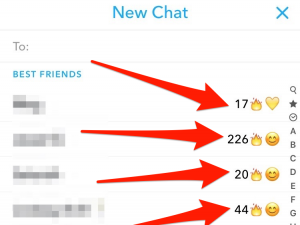Since its release in April 2011, Snapchat has had many updates and remodelling such as the addition of stories, infinite snap time, stickers for decorating, lenses, and many other features added to improve the user experience. In 2015, the app began to count the number of consecutive days that users snapped each other, later being called “streaks”. This number was marked with a small flame emoji next to the names of the user’s friends. Initially, it seemed like something that would be coincidental, something that was interesting but just there as an indicator that you had snapped a person within 24 hours of them snapping you for a couple of days. However, as Snapchat has become more popular, streaks have become the normal way many teens use the app to interact with each other.
The “streak” has become a constant type of snapchat that teens send and receive. What was once an indictor of casual communication has become a marker of friendships and loyalties. A majority of teens now will wake up in the morning with many snapchats from their friends that are “streaks”, a snapchat only sent to preserve and keep the number going. They range from person to person. Some are morning selfies, pictures from their window, or even black screens with a single “S”. Either way, these “streaks” are sent to keep it going, not necessarily because a user wants to send something to a friend of theirs. This concept has taken over the way Snapchat is used and made us more robotic.
Stephen Marche’s article, Is Facebook Making Us Lonely? asks the question if our social media presence is changing our real life presence? Is the media made to help us be more social and communicate, isolating us and making us lonely? In terms of Snapchat, it seems so. The streaks are only being kept for the number, not the friendship. Often users will have streaks with people that they aren’t very close with in person, with their streak being one of the only connections they have with each other. It has created a new dynamic that builds on the idea of having a fake social media presence that does not translate to real life. Similarly with Facebook, users add friends that might only be acquaintances, building up a false sense of friendship and commitment to their person. Streaks have taken out the fun of Snapchat and created another social platform ruled by numbers.
 WORK CITED
WORK CITED
Kostovetshy, Kathryn. “I Broke All Of My Snapchat Streaks And You Should Too”. The Odyssey Online, 2018, https://www.theodysseyonline.com/broke-all-of-my-snapchat-streaks-and-you-should-too. Accessed 7 Nov 2018.
Marche, Stephen. “Is Facebook Making Us Lonely?”. The Atlantic, 2018, https://www.theatlantic.com/magazine/archive/2012/05/is-facebook-making-us-lonely/308930/. Accessed 8 Nov 2018.
Molloy, Mark. “Who Owns Snapchat And When Was It Created?”. The Telegraph, 2018, https://www.telegraph.co.uk/technology/0/owns-snapchat-created/. Accessed 4 Nov 2018.
Vega, Nick. “I Just Lost A 159-Day Snapchat Streak And I Couldn’t Be Happier”. Business Insider, 2018, https://www.businessinsider.com/snapchat-streak-lost-couldnt-be-happier-2017-8. Accessed 6 Nov 2018.
I think that using Snapchat as an example of how social media makes us lonely is a very compelling argument. The concept of streaks is a very controversial topic nowadays and by identifying how it is, in fact very similar to how Facebook impacts our social life is very eye-opening to how social media has evolved. Perhaps consider how the company used this concept to their advantage to keep teens hooked on the app and how the purpose/ intent of Snapchat users have evolved over the years. You have made a strong point that really reflects the controversy of social media discussed in the article, “Is Facebook Making Us Lonely?”